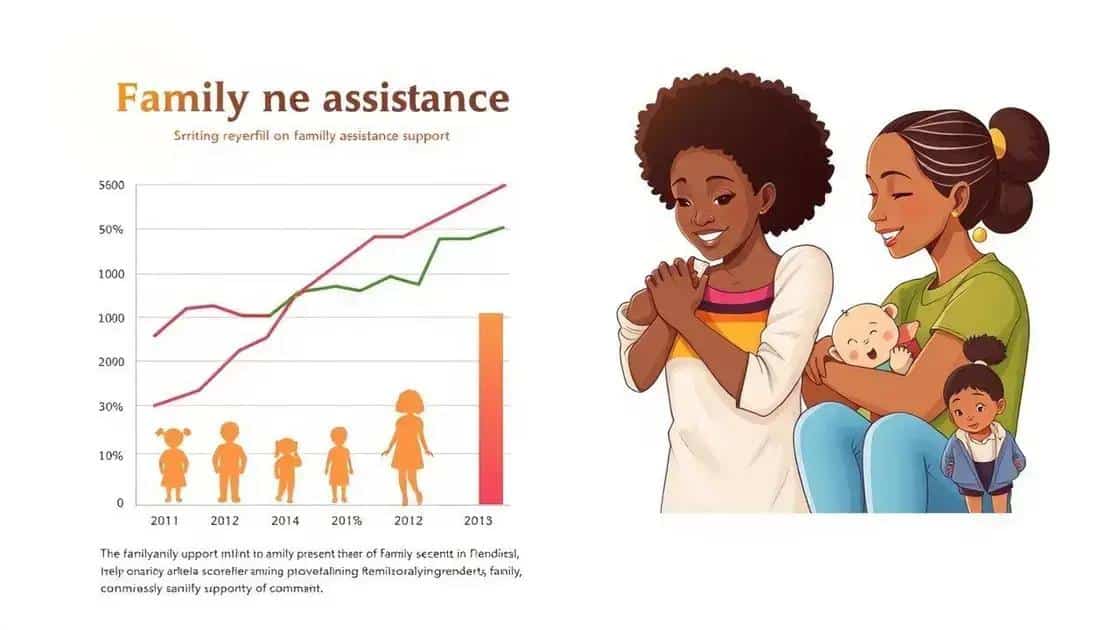Family support benefits trends: what to expect in the future

Family support benefits trends indicate increased funding, technological integration, and holistic approaches in the future, enhancing access to resources for families in need.
Family support benefits trends are evolving, reflecting changing societal needs. Have you ever wondered how these shifts can enhance your life and community? Let’s dive in.
Emerging trends in family support benefits
Emerging trends in family support benefits are reshaping the way we view community assistance. As society evolves, so do the needs of families. Understanding these changes can help individuals and policymakers adapt effectively.
Increasing Accessibility
One of the most notable trends is the increased accessibility to family support benefits. Governments are implementing online platforms that streamline applications, making it easier for families to access necessary aid. This shift aims to reduce barriers and ensure that help is available to those who need it most.
Focus on Mental Health
Another important aspect is the growing emphasis on mental health resources within family support benefits. Families today face numerous pressures, and support programs increasingly recognize the importance of mental well-being. As a result, many benefit packages now include:
- Access to counseling services.
- Workshops on stress management.
- Resources for mental health education.
These resources are designed to promote healthier family dynamics and provide tools for navigating challenges.
Furthermore, there is a rising trend toward tailoring benefits to meet specific family needs. This includes considerations for single-parent families, multicultural households, and families with special needs. By personalizing support, programs can offer more effective assistance and foster a sense of inclusion.
Community Engagement
Engagement at the community level is becoming essential in shaping family support benefits. Many organizations are now collaborating with community leaders to ensure that support systems are aligned with local requirements. This collaborative approach enhances responsiveness and increases trust in available programs.
With these evolving trends, families can expect a more supportive environment that not only addresses their immediate needs but also promotes long-term stability and resilience. Staying informed about these changes enables families to make the most of the resources available to them, ultimately leading to stronger communities.
Key statistics on family assistance trends

When exploring key statistics on family assistance trends, it’s important to understand the numbers that reflect changing needs. Data shows an increasing reliance on support systems among families. These statistics provide valuable insights into how assistance programs need to adapt.
Rising Numbers of Families Seeking Assistance
Recent reports indicate that more families are requiring aid than ever before. In fact, over the past five years, there has been a 25% increase in applications for family support benefits. This rise highlights the growing economic pressures many households face.
Impact of Demographics
Statistics reveal that certain demographic groups are more affected by these trends. For instance:
- Single-parent families make up nearly 40% of all applicants.
- Low-income households represent 65% of those receiving assistance.
- There has been a notable increase in multi-generational households seeking aid.
This data underscores the need for tailored support that meets diverse family structures and situations.
In addition to the rise in applicants, funding for family assistance programs has also seen changes. Government budgets are increasingly allocating more resources to these benefits, with a 15% increase in funding observed in the last fiscal year. This proactive measure aims to ensure families don’t face a crisis alone.
Long-term Trends
Understanding long-term trends in family assistance is crucial. Over the last decade, programs have shifted from solely providing financial aid to offering comprehensive support, including:
- Job training programs.
- Educational resources for children and parents.
- Mental health services.
This broader approach reflects an understanding that families need more than just financial help to thrive. As we analyze these statistics, it becomes clear that effective support systems are vital for fostering resilience and stability in families.
The impact of family support on community health
The impact of family support on community health is profound. Strong family ties can lead to healthier individuals and, in turn, healthier communities. When families receive adequate support, they are better equipped to manage stress and promote well-being.
Improved Mental Health
Families that have access to resources often show significant improvements in mental health. A supportive home environment reduces the risk of depression and anxiety. Studies indicate that those with strong familial support experience:
- Lower stress levels.
- Higher self-esteem.
- Better coping mechanisms during crises.
This positive influence radiates into the community, fostering a culture of care where individuals feel more connected and supported.
Physical Health Benefits
In addition to mental health, family support plays a crucial role in physical health outcomes. Families that prioritize health and wellness often encourage healthy habits, such as:
- Regular exercise and physical activity.
- Balanced nutrition and meal planning.
- Consistent medical check-ups and preventive care.
These habits contribute to a healthier population, reducing the burden on healthcare systems and promoting community wellness.
Moreover, communities with strong family support networks tend to have lower rates of chronic diseases. This is because when families communicate about health and make joint decisions, they can mitigate risks like obesity and heart disease.
Creating Resilient Communities
A supportive family structure also fosters resilience in communities. When families thrive, communities can rebound from challenges more effectively. This resilience is evidenced in the ability to:
- Respond to natural disasters.
- Support local businesses during economic downturns.
- Engage in community improvement initiatives.
The connections formed within families translate into collaborative efforts, which ultimately lead to stronger community ties and collective well-being.
Future forecasts for family support benefits

Future forecasts for family support benefits show promising trends that could enhance the lives of millions. As society continues to evolve, these changes are crucial for adapting assistance programs to meet new challenges.
Increased Funding
Experts predict a significant increase in funding for family support initiatives in the coming years. Governments are recognizing the importance of these programs, and we can expect budgets to grow by at least 20%. This funding boost will help expand services and make them more accessible to families in need.
Adoption of Technology
Another trend is the adoption of technology in service delivery. Family support programs are increasingly using digital platforms to streamline applications and provide resources. This shift is expected to:
- Enhance the user experience with online resources.
- Automate processes to reduce wait times.
- Facilitate virtual consultations and support.
These advancements will ensure families receive timely assistance, which is crucial in times of crisis.
Moreover, the focus on data-driven decision-making will lead to more targeted support. As more data becomes available, assistance programs will be able to tailor their services to the specific needs of different communities. This customized approach is expected to improve overall effectiveness and satisfaction among beneficiaries.
Holistic Support Systems
Future family support benefits will likely include more holistic measures. This means integrating resources not just for financial aid, but also for mental health, education, and job training. Such comprehensive support will be key in addressing the root causes of family struggles:
- Access to mental health counseling.
- Educational and skill development programs.
- Employment assistance and career counseling.
This holistic approach is designed to empower families and help them achieve long-term stability.
FAQ – Frequently Asked Questions about Family Support Benefits
What are family support benefits?
Family support benefits are programs designed to assist families in need with financial aid, resources, and services to improve their well-being.
How are family support benefits expected to change in the future?
Future forecasts suggest increased funding, greater use of technology, and more holistic support systems to better address the needs of families.
Who qualifies for family support benefits?
Eligibility varies by program, but generally, low-income families, single-parent households, and those experiencing financial hardship are eligible to apply.
How can technology improve access to family support benefits?
Technology can streamline application processes, provide online resources, and enable virtual consultations, making assistance more accessible to families in need.





